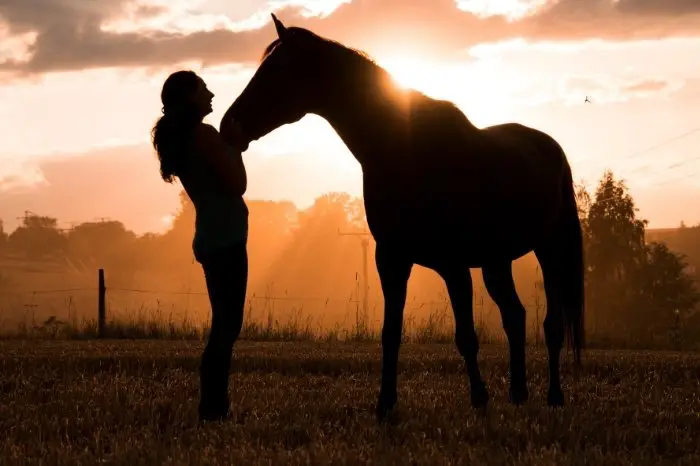Last Updated on April 26, 2022
When it comes to comparing horse vs human anatomy, you may have heard that horse legs are fingers. In a way, this comparison can be made when studying the anatomy of both horses and humans. Horses have fascinating anatomy and for horse owners, it is important to understand how their bodies work.
Across the span of millions of years, horses have evolved from small forest creatures into the beautiful animals we love today. They have evolved to be fast, powerful animals that can pull heavy loads and carry weight on their backs. Their unique conformations give them the ability to ride and drive.
Horse Vs. Human Anatomy – Horse Legs Are Fingers?
Horse and human skeletons are more compatible than many people realize. Though we stand on two feet and horses stand on four feet and have much larger bones, there are similarities between the two.
Horses have 205 bones, whereas humans have 206 bones. Both horses and humans have pelvic bones, but horses do not have collar bones. Since they don’t have collar bones, the front limbs of a horse are held on by soft tissue (muscle, tendons, and fibrous sheets of fascia).

Though horses’ lungs are similar to ours, their digestive tract is very different. The most interesting similarity between horses and humans is in the limbs.
Click Here to Get Info About:
Comparison: Horse Legs Are Fingers
Millions of years ago, horses used to have five toes. As they evolved, horses grew to have only one hoof on each leg. However, many researchers believe that the five toes are still there, just in various forms of development.
Scientists have long believed that the one remaining toe, which starts at the knee or hock and ends at the hoof with the hoof wall, is the third (middle) toe. This toe survived the steps of evolution to modern-day.
Many agree that the second and fourth toes became the splint bones which sit on either side of each cannon bone. However, the first and fifth toes, though genetically programmed to exist, supposedly become reabsorbed in the embryonic development process.
However, some scientists think that the first and fifth toes don’t get reabsorbed. They simply just become forms that aren’t necessarily something we would have recognized. Some scientists believe that the palmar and plantar processes of the coffin bone are the remnants of the first and fifth toes.
Formula 707 Joint 6in1 Equine Supplement Bucket- Support for Joint Integrity
These bones, the palmar and plantar, ‘stick out ‘from the coffin bone. They are also prone to fractures during kicks or extreme use of the leg.
Additionally, toe remnants can also be seen on the bottom of the hoof. The frog’s unique V shape represents the bottom part of the second and fourth toes. On the other hand, toes one and five appear in the form of the ridges on the sides of the frog.
Today, the comparison between a horse’s skeletal structure is very interesting compared to humans. When comparing a horse’s leg to a human, a human would be walking on their fingertips. The bones in their legs can be compared to the bones in our arms, legs, feet, and hands.
Read more about Can Horses Drink Beer? And Is Beer Good For Horses?
Parts Of A Horse’s Leg And How It Compares To A Human
When it comes to a horse’s leg compared to a human skeleton, there are some interesting comparisons that can be made. Their hooves are like our fingernails, so it would be like us walking on our middle fingertips.
A horse’s knee is like a human wrist and the cannon bone is like the wrist to our knuckle, with the splints being remnants of what our other palm bones are. What we call our knees are like a horse’s stifle and our heels are like a horse’s hocks.
From the fetlock to the ground on a horse is like our fingers and toes. Just like how our nail grows from the cuticle, so does the hoof from the coronary band. On the back leg, a horse’s cannon bone is like our metatarsal bone.
Human hands and feet are well supplied with muscle. On the other hand, the forelimbs and hind limbs of the horse are basically devoid of muscle from their so-called knees and hocks and below. The tendons and ligaments work as a “spring loading” system of recoil that adds to a horse’s efficiency of movement.
Since humans stand upright and they horses don’t, this creates the forelimb concussion issue for the horse. However, it also works to load the spring.
The Fascinating Anatomy Of The Horse – Horse Legs Are Fingers?
Horses have unique anatomy that is quite special. They once had five toes, but over millions of years only evolved to have one. However, remnants of the other four toes are still seen today in the leg and bottom of the hoof. The one remaining toe that horses have starts at the knee or hock and ends at the hoof with the hoof wall, is from the third (middle) toe.
Do you have any questions regarding horse legs are fingers? If so, please ask any questions regarding horse anatomy in the comments below.

